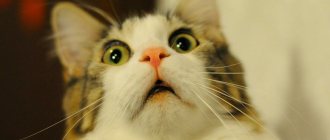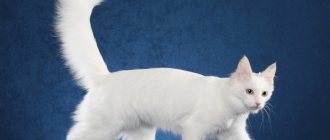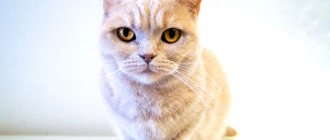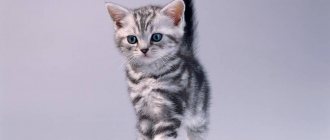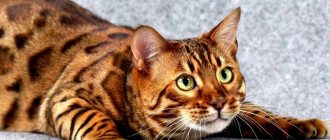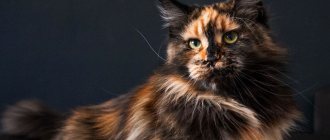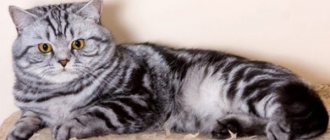11/13/2021 12,515 Cat breeds
Author: Olga
For the uninitiated, it may be a discovery that the Briton is not only a large cat with a noble ash color. This could be a pet with a completely unusual intricacy of stripes and spots on a beautiful fur coat! Therefore, let's talk about one of the most spectacular colors of British cats - marbled.
[Hide]
British among cats
This breed is popular due to its independent and patient disposition, because British women will never get bored in the absence of their owner. At the same time, plush purrs are not devoid of a sense of tact and show full love to those who take care of them and treat them with tasty treats.
British cats are the embodiment of calm and intelligence
The British are distinguished by high intelligence - by changing the “notes” in the breadwinner’s voice, the cat will understand that it is doing something wrong. However, these little cats cannot be called too mischievous or vindictive - calmness is their strong point. At the same time, British cats are not inclined to become toys in children's hands; with excessive attention from children, the cat will prefer to run away.
Externally, British catfish differ in the following parameters:
- thick coat with dense undercoat;
- round, close-set eyes of amber color;
- massive head on a short neck;
- wide cheekbones;
- small nose with a wide bridge;
- ears widened at the base with rounded tips;
- muscular body on wide, strong legs;
- medium-length tail, rounded at the end.
Communication and perception
Like domestic cats, marbled cats can purr and meow, however their "meow" is described as a chirping sound instead of a more continuous sound. They rely heavily on their vision to see in low light conditions. Their shorter and more rounded skull with flattened nasal bones gives them a more spacious view. This morphology, combined with large amber eyes with vertically oriented elliptical pupils, provides the maximum vision needed for locomotion in low light conditions.
How the color of the Briton was formed
There are several versions of the origin of the breed - one says that the ancient Romans brought cats from the Egyptian desert in the 1st-2nd centuries. ad. According to another legend, British cats originate from the purring Chartreuse breed, taken by medieval crusaders from the shores of South Africa.
Chartreuse cats are considered possible ancestors of the British breed
The first true Britons who settled Foggy Albion had gray-blue “stuffed” fur. This is how they were depicted in religious treatises (for example, in the Lindisfarne Gospel), poems and bestiaries. Zoologists began selection, which fixed the color, only in the 19th century, at which time the first breed standard was drawn up.
Color is the color scheme and patterns on a cat's fur coat that are formed as a result of the interaction of genetic materials responsible for the production of melanin in the body. The desired shade of coat is obtained by crossing animals with dominant and recessive genes responsible for the pattern and depth of tone. So, in British dogs with blue hair, the set of genes looks like BBdd (where B is the dominant gene that forms the black color, and d is the recessive gene responsible for muted, diluted shades). Marbled cats carry the Tb gene (where T is the dominant tabby color gene, and b is a recessive gene that makes the coat brownish, not black).
Felinologists became concerned with professionally establishing breed characteristics (including color) in British cats only after the Second World War, when the question arose of preserving this variety of domestic purrs:
- 1950 - official recognition of the British Blue breed;
- 1967 - British blue cats received the champion title from the ACA association;
- 1977 - ban on mating with other breeds, including Chartreuse;
- 1980 - recognition of the breed by the CFA Association.
Description of tortoiseshell color
Colored spots (red and black) are evenly and chaotically distributed throughout the cat’s body. Both colors must be present on the legs. For all tortoiseshell cats, regardless of breed, it is very desirable to have a red (red or cream) spot on their face - a flame.
It is welcomed when there is a red-red smear on the cat’s face
A breeder I know says that tortoiseshell cats are conventionally divided into groups based on the size of their spots. If the motley pattern visually resembles fish scales, while small black and red spots are combined in a chaotic manner, overlap each other and do not have a clear separation from each other, then this color is called scaly. If areas of different colors are larger, clearly distinguishable and have clearly defined boundaries, then this coloring is called patchwork.
The tortoiseshell cat's coloration may resemble fish scales.
Table: varieties of tortoiseshell cat colors
| Color variety | Code | Coat color | Coloring of the iris | |
| Filled | Black | f | red and black | orange-yellow, copper-golden |
| Chocolate | h | red and brown | orange, copper | |
| Cinnamon | q | red and light brownish | orange | |
| Diluted | Blue | g | Gray (blue) and cream | copper-golden, yellow-orange, sometimes green |
| Lilac | j | lavender (lilac) and cream | orange-lemon, copper, green | |
| Fawn | r | soft sand (fawn) and cream | orange, green |
The color of the skin on the nose and paw pads corresponds to one (predominant) solid color that makes up this tortoiseshell color variety.
Colored spots can be large and combined with white
Breeders distinguish tortoiseshell in combination with white, the spots of which are located below (on the abdomen, paws, neck and chin) as a separate subtype.
Video: cats with lights
Where does the British marbled cat come from?
Since the beginning of the 20th century. British cats included not only plain blue animals, but also tabby cats with different shades on their fur coats. Thus, in 1901, American felinologists registered a Belle cat with a red tabby color.
British marbled cats appeared as a result of crossing with other breeds
The consequence of two world wars was the almost complete extermination of the British breed, so breeders began to crossbreed pets with representatives of other varieties - Burmese, Russian Blues, Persians and Scottish. The result was the appearance of many varieties of British color while simultaneously preserving the breed characteristics (wide paws, protruding cheekbones, “plush” coat).
At the same time, among all the variations of the striped coat of the British fur coat, it is the marble color that is considered classic, occurring naturally. Zoologists are inclined to believe that the symmetrical darkening on the fur of catfish from Foggy Albion is an inheritance from wild Asian or African ancestors.
Some breeds and types of marble
The merle color is found in various varieties in many domestic cat breeds.
Bengal marble
He is very unique. These hybrid cats have primary color patterns of gold, silver, snow and charcoal, but always with a tabby pattern. These can be bright spots, peculiar “rosettes” or various stains. That’s why they call marble “on gold”, “on silver”, snow and coal.
The type of pattern itself is also different. If you don’t delve into the special terminology, but accept the generally accepted one among breeders, then it can be of the “cloak” and “sparble” type.
Cloak marble is the most inexpressive pattern, when dark lines practically merge and overlap the main background. Such animals are poorly valued.
But sparbles are highly valued. These cats can be said to combine large two-color rosettes and large concentric circles on the sides, belonging to true classic marble. Usually such animals are the brightest and most expressive in the litter, with bright glitter.
Bengals do not have tortoiseshell marbles.
British marble
It is common in closely related breeds - the British and the Scots, which differ only in the shape of the ears; in the latter they are bent forward and hang down.
This is one of the oldest breeds of domestic cats in Europe. Received by crossing street, English and Persian individuals. The structure of their short, printed coat with abundant undercoat is reminiscent of teddy bears.
By nature, these animals are quite capricious, lazy, independent and picky. But with proper training, they make excellent pets.
The merle color can be regular or tortoiseshell. It is these breeds that have the greatest difficulties in breeding this color due to the moire factor.
Asian tabby
The name of the breed itself speaks about the color characteristics. Bengal wild type marbles are common. But moire is quite common, since the breed was obtained by crossing a Burmilla and an Abyssinian, which is distinguished by high ticking.
These animals are very active, playful and restless. They are extremely attached to their owner and distrustful of strangers.
American Bobtail
It is also distinguished by a variety of colors, among which marble in various color variations is not the least important.
This is an American breed, bred in the 50s of the last century. The main distinguishing feature is the short tail, which is often called a bob. The coat can be short or medium length.
Smart, sociable, independent pets are excellent companions for all household members.
Read more in the article about American Bobtails.
Bramble
This very young breed (2000) bears the name of its creator Harry Bramblett. In addition, it is also used in consonance with the English word for “thorn” - “bramble”.
Obtained by crossing a Bengal cat and a Peterbald with a brush coat. Therefore, the marble of these cats is of the Bengal type, and the fur itself resembles a hard wire in appearance, but is soft to the touch. This is currently an experimental and very rare variety.
In character they are unusually reminiscent of Bengal.
Bohemian rex
Extremely rare animals. They were bred in the 80s of the last century, but breeding work has practically ceased.
They descended from short-haired Persians with a rare gene for curly hair, apparently accidentally introduced during crossings during the selection of German Rexes.
Very cute and obedient pets come in a variety of colors, including marbled ones.
Devon Rex
Can also be marbled. It was this breed that was formed due to a random mutation.
This was discovered when an attempt was made to cross them with Cornish Rex. The genes of the two species turned out to be different; the desired result did not work out.
Like all curly-haired cats, Devon Rexes resemble in their behavior the symbiote of a monkey, a dog and a cat. Cheerful, energetic, restless pets are loving, intelligent and trusting.
Napoleon
This amazing animal only recently received the title of a provisionally recognized breed six years ago, but has won the love of the whole world due to its unusual appearance and chic character.
American breeder Joe Smith crossed Persians and Munchkins to get a long-legged variety of the latter, but the result was short-legged Persian cats that absolutely did not inherit the warlike and harmful temper of their ancestors.
The colors of the breed are varied, marbled Napoleons are one of the most beautiful cats in the world.
Other breeds
These are not all breeds, among whose representatives marble beauties are often found. These also include:
- American Shorthair and Wirehair;
American shorthair cat
- American Curl;
- Brazilian Shorthair;
- European Shorthair;
- California radiant;
- Kanaani;
- Karelian, Kuril and Japanese bobtails;
Two Karelian bobtails
- Cymric;
- Laperm;
- Lamkin;
- Munchkin;
- Manx;
- Maine Coon;
- Norwegian Longhair;
- Oriental and many others.
Types of merle colors among the British
This color belongs to a group of colors called tabby (from the name of the striped fabric brought to England from Baghdad). The peculiarity of this pattern is the continuity of lines and the uniqueness of the pattern for each individual. Thanks to the efforts of felinologists, today the British marble coat is represented by many varieties.
Black marble
The main background of the coat is dark gray, the stripes have a pronounced black tint. There is a black outline around the eyes and nose, the color of the eyes is brown-orange.
British black marble shades are highly prized by animal lovers.
Black marble on silver
Charcoal stripes and spirals are symmetrically arranged on a silver background. There are dark spots near the eyes and the red-brown nose.
Black marble on silver - exquisite colors of British cats
Black marble on gold
The main color of the coat is copper-golden, the stripes have a black or dark brown tint. The eyes are most often green or yellow.
The British with the “black marble on gold” color look very presentable
Lilac marble
The silver fur coat is decorated with patterns of lavender or peach undertones. There is also a lavender rim around the nose and eyes. The iris is yellow or pale brown.
British cats with a lilac-marble hue are quite unusual
Tortoise marble
The main background can be silver-red or silver-brown, while the spots and patterns remain black or dark brown. The eyes are often yellow or greenish. The color is characteristic only of females; in rare cases it is found among males. Cats with this color cannot have offspring due to genetic characteristics.
Tortoiseshell marble involves adding reddish shades to the main color scheme
Chocolate marble
The fur coat is the color of milk chocolate, the pattern is dark brown. The eyes and nose are outlined with thick chocolate eyeliner. The color of the iris is from yellow to golden brown.
Chocolate Marble is a common color option among the British.
Bicolor
The main color with spots is diluted with white inserts on the paws, chest and belly. Eyes can be yellow, brown or green.
Bicolor color is also found among British harlequins.
Red marble
The light red fur of the main background is decorated with spots and streaks of a rich red hue. The eyes are orange, brownish-golden.
Red merle is a red British breed with merle patterns on their coats.
Red marble on silver
It is distinguished by a silvery tone of the main background, the spots have a light red color. The fur around the eyes is white, the nose is pink. The eyes are yellow or golden.
Red marble on silver - a spectacular coat color for the British
Cream marble
The main background has a shade of creme brulee, and the spots tend to be peach. There are white hairs around the eyes and a pink nose. Eyes yellow or gold.
Cream marble is a very delicate shade of the fur of British cats.
Blue marble
Silver coat with smoky gray stripes and spots, dark gray lining around the nose. The eyes are not circled and have a brown-golden tint.
The British in the shade of “blue marble” look noble
Breeding marbled kittens
The British marbled kitten is considered one of the most recessive species. Therefore, if the goal is to obtain just such a color, you should not allow an animal that has a single-color coat to be mated. Most likely he will defeat the marble gene.
To breed merle-colored cats, it is necessary to select for mating both participants with the required data: a pattern on the forehead in the form of the letter M, dark eyeliner and nose, rings on the tail, light spots on the back of the ears.
The most popular British kittens today are black marbled on silver.
Marble color standards
In addition to the basic standards of the breed, additional requirements have been established for British merles, which must be present in the exterior. The absence of at least one sign leads to the culling of the pet and the inability to participate in further breeding.
Marble British should have a clear pattern
Interestingly, the classic letter “M” on the forehead of tabby cats is associated with the prophet Mohammed. Allegedly, when the saint picked up a marble cat, the hair on its head became colored in a specific way. Which became a sign of the Higher Powers’ love for these purrs.
So, the marbled British cat is distinguished by the following characteristics:
- brightness, symmetry and clarity of the pattern on the fur coat;
- absence of intersections and broken lines in the patterns;
- the hairs are colored in two ways (in several shades - the hairs of the main background, in one color - the hairs of the patterns);
- the color of the iris depends on the shade of the coat; it can be copper, hazel, greenish or brown;
- there are “necklaces” on the chest, and two dark curls running parallel on the cheekbones;
- the forehead is marked with a pattern in the shape of the letter “M”, on the back of the head and shoulders there is a pattern in the form of a butterfly;
- the outer side of the ear closer to the base has a white spot;
- three long stripes of distinct dark color stretch along the ridge;
- the hips are marked with circular closed patterns;
- the tip of the tail is always marked in a dark color;
- There is a bright outline around the eyes and nose.
In addition, a classic marble cat should have small, far-set ears and massive paws. At the same time, the color of the skin on the pads of the paws, as well as on the nose, depends on the color of the animal’s fur - the darker the fur, the richer the skin tone. Seals with a silver background have pink paws and noses, red ones have crimson purrs, and “dark” British cats are completely brownish.
Table: EMS codes for coat colors in cats
| Code number | Transcript (in Russian) | Transcript (in English) |
| Main color | ||
| a | blue (blue) | blue |
| b | chocolate (Havana, brown, champagne, chocolate) | chocolate (brown, chestnut) |
| c | lilac (platinum, lilac, lilac) | lilac (lavender) |
| d | red (ed) | red (flame) |
| e | creamy | cream |
| f | black tortoiseshell (sil-torti, tortoiseshell) | tortoiseshell |
| g | blue tortoiseshell (blue-cream tortoiseshell, blue cake) | blue-tortie (blue-cream) |
| h | chocolate turtle (chocolate cake) | chocolate-tortie |
| j | lilac tortoiseshell (lilac-cream tortoiseshell, lilac-torty) | lilac-tortie |
| m | caramel | caramel |
| n | black (ebony, sable, wild, seal) | black (ebony, sable, ruddy, seal) |
| o | cinnamon (sorrel, honey) | cinnamon (sorrel, honey) |
| p | faun (beige, fawn) | fawn (beige) |
| q | Tortoiseshell cinnamon (cinnamon cake) | cinnamon-tortie (sorrel-tortie) |
| r | tortoiseshell fawn (fawn-tortie) | fawn-tortie |
| s | silver | silver |
| t | amber (amber) | amber |
| w | white | white |
| y | gold | golden |
| x | unregistered color | unregested |
| Degree of white spotting | ||
| 01 | van | van |
| 02 | harlequin | harlequin |
| 03 | bicolor | bicolour |
| 04 | bicolor for color points | mitted\white point |
| 05 | snowshoe | snowshoe |
| 09 | small white spots | little white spots |
| Tipping degree | ||
| 11 | shaded (shaded, shedded) | shaded |
| 12 | chinchilla (veil, veiled, tipped, shell) | tipped (shell) |
| Type of drawing | ||
| 21 | tabby, agouti | tabby (agouti) |
| 22 | marble (marble) | blotched (marble, classic) |
| 23 | tiger (mackerel) | tiger (maskerel) |
| 24 | spotted (rosette) | spotted |
| 25 | ticked | ticked |
| Acromelanic colors | ||
| 31 | Burmese (sepia) | burmese (sepia) |
| 32 | Tonkinese (mink, mink) | tonkinese (mink) |
| 33 | Siamese (Himalayan) | siam (himalayan) |
| 34 | Singaporean | Singapore |
| Tail length | ||
| 51 | rampy | rumpy |
| 52 | ramp riser | rumpy riser |
| 53 | stumpy | stumpy |
| 54 | longs | longy |
| Eye color | ||
| 61 | blue | blue |
| 62 | yellow | yellow, golden |
| 63 | disagreement | oddeyed |
| 64 | green | green |
| 65 | Burmese color | burmese color |
| 66 | tonkinese color | tonkinese color |
| 67 | siamese color | siam (himalayan) color |
| Ear shape | ||
| 71 | straight | straight |
| 72 | curl | curled |
| 73 | fold | fold |
| Coat type | ||
| 81 | long wool | longhair |
| 82 | short hair | shorthair |
| 83 | brush | brush |
| 84 | straight | stright |
Tabby cat breeds
Now we list the most popular tabby cat breeds:
- Abyssinian cat
– The most common of the Abyssinian colors is the wild, ticked tabby. The fur looks red-brown, but each hair is colored in several shades at once - from light red to brown and black, which gives the impression that the color shimmers with light-dark shades of brown. From the patterns, stripes in the form of “M” and darkening at the tip of the tail are noticeable;
- British tabby cat
– the most common coat color of pets of this breed is blue, but there are other colors, for example, tortoiseshell, rare black, white, lilac and fawn. Among the British there are also individuals with tabby and tabby point colors;
- Scottish tabby cats
(Scottish folds and Scottish straights) - such pets with hanging and straight ears can be solid solid (black, red, white, etc.), smoky and colors combined with white spots. But straight-eared and fold-eared cats with patterns on their fur, for example, silver, blue or brown tabbies, look especially impressive;
- Siberian tabby cat
– this beauty, who is our compatriot, can also be tabby in color. The luxurious striped color looks especially beautiful on the thick, semi-long coat of Siberian cats;
- Persian tabby cat
– fluffy Persians come in different colors, including their coats and tabby patterns. It’s just that it’s not always possible to clearly see marble stains or tiger stripes on such a long and thick coat. However, the characteristic letter “M” on the forehead and the rings on the tail are almost always clearly visible;
- Pixie-bob tabby
- It’s funny, but these popular cats today with short tails and tufts on their ears, first bred in Canada, are mistaken by some people for ordinary outbred animals that have lost part of their tail after getting into trouble. The color of pixie-bob cats is chocolate or gray-gray of varying saturation with the obligatory tabby markings;
- Kurilian Bobtail Tabby
- a young Russian breed bred in the 90s of the 20th century. The color of such cats can be decorated with tabby patterns, but provided that the main coat color is not fawn, lilac, chocolate or cinnamon. But black, red (red), cream, blue, silver, tortoiseshell tabby (possibly with white spots) are not prohibited by the breed standard;
- Thai tabby cat
– it is more correct to talk about the color of animals of this breed “Thai tabby point cat”. These pets have the main part of their fur white, and the ears, tip of the muzzle, paws and tail are colored brown, blue, red or cream. In addition, Thai tabbies have characteristic markings on their bodies (for example, tiger stripes or small circles on the body, the letter “M” on the head, rings on the tail, etc.). It is noteworthy that Thai kittens are born white, and only then point spots of a different color and characteristic tabby markings appear on their coats;
- Singapore tabby cat
– in color, miniature Singapuras are a little similar to Abyssinian cats, only their fur is light cream, with brown shading on the face, back and tip of the tail. The eyes and miniature nose of these pets appear circled. Each coat of Singapore ticked tabbies is colored in several shades at the same time - from almost white to chocolate brown. It is noteworthy that all Singapore cats are the same color;
- Asian tabby cat
– we are talking about Bengal, Sumatran cats and fishing cats – wild animals living in Asian countries. Sometimes they are kept as pets, but by nature they are free animals. Their fur coats also show distinct tabby patterns, which are not used as decoration at all, but for camouflage during hunting.
Anomalies and features of merle color in the British
A plush fur coat with streaks and patterns reminiscent of a cut on marble is considered one of the most difficult in terms of proximity to standards. If you plan to purchase such a kitten, breeders and experienced owners recommend taking a baby no younger than 4–6 months of age. By this time, the pattern on the coat will be completely formed and the slightest deviations from the norm will be noticeable.
British merles have the same developmental anomalies as other cats.
At the same time, British harlequins have clearly marked stripes and circles on their coats from birth. If the degree of coloration of the hairs in the pattern is excessive, then the final pattern will be blurry. Then they talk about “false marble”, or moire, among the British. This is an anomaly due to which the animal is not allowed to be bred.
Disadvantages that reduce points at exhibitions:
- torn edge of the pattern;
- The picture is too large and overlaps the main background.
Anomalies leading to a ban on procreation:
- polydactyly;
- too many rings around the eyes;
- kinks on the tail;
- disorders in the structure of the jaw.
SPOTTED TABBY, LEOPARD COLOR BRITISH
The British spotted cat can also be called Spotted tabby or leopard, which, in principle, is the same thing. The color must invariably include: the letter “M” on the forehead, “necklaces”, stripes on the paws, rings on the tail, spots on the belly, a contrasting pattern, eyeliner and nose, all according to the standard.
The spotted color is the most common of all tabby colors. The British spotted cat looks elegant and looks like a leopard, which is why it received this second name for the color. British spotted kittens can be born from parents of any tabby color. Eyes can be copper or green (green eye color is characteristic of golden and sometimes silver colors).
We suggest you read: Childbirth in a cat - how to give birth to a cat at home?
Photo of a British tabby kitten, black silver spotted color BRI ns 24
| British tabby, photo of chocolate silver ticked British kitten BRI bs 25 | Photo of a British tabby kitten: lilac ticked BRI c | British tabby cat, photo of golden ticked Briton BRI ny 25 |
| Photos of British tabby kittens: red ticked color BRI d 25 | British tabby cat, photo of red silver color BRI ds 25 | British cat tabby color, photo of cream silver ticked color BRI es 25 |
| British spotted cat cinnamon BRI o 24 | British brindle kitten, photo red British BRI d 23 | British brindle (striped) tabby cat, photo of a chocolate tabby British kitten BRI b 23 |
| British tabby (tiger) cat, photo of black silver British tabby BRI ns 23 | British spotted cat, photo of blue spotted tabby color BRI a 24 | British tabby, photo of lilac spotted British tabby kitten BRI c 24 |
| British tabby, photo of tortoiseshell spotted color BRI f 24 | British tabby cat, photo of chocolate spotted British kitten BRI b 24 | Leopard tabby color, photo of golden spotted British kitten BRI ny 24 |
| British tabby, photo of tortoiseshell tabby color BRI q 23 | Marbled British kitten, photo of chocolate marbled British kitten BRI b 22 | British merle kitten, photo fawn harlequin color BRI p 22 |
| Marbled British cat, photo cinnamon marbled color BRI o 22 | British tabby cat, photo cream tabby color BRI e 22 | British marble on silver, photo red marble British tabby BRI ds 22 |
| British kitten, photo of marbled chocolate color BRI b 22 | British merle cat, photo lilac merle British tabby BRI c 22 | British merle kitten, photo of black golden merle BRI ny 22 64 |
| British black marbled on silver, photo of tortoiseshell silver British kitten BRI fs 22 | British blue marble, photo of black blue marble British tabby kitten BRI a 22 | British merle cat on silver, photo of black merle British tabby color BRI ns 22 64 |
| Silver merle Briton, photo of British merle color on silver tabby BRI ns 22 | British tabby, photo color point tabby color BRI a 33 21 | British cat black marbled bicolor, photo of color black silver marbled bicolor tabby BRI ns 03 22 |
Caring for the British Marbled's fur coat
The breed is one of the cleanest and neatest cats, so the animal often takes care of its appearance on its own. At the same time, it is recommended to wash the cat every six months and comb its elegant fur at least once a week.
British marble cats do not require special care
Since the coat of British cats is quite elastic and flexible, there are no special rules for caring for it. It is recommended to regularly clean the animal’s ears (with cotton swabs dipped in warm water) and the animal’s eyes (with warm and damp cotton pads) - every 7-10 days.
Video: British marbled cat
A little history
The British cat breed is considered natural, but many coat colors and colors were developed through selection and use of cats from other breeds. The selection usually involved Persians and exotics; these breeds have quite a lot in common with the “British”, and therefore, when developing new colors, the established breed standards were not affected.
But also, according to one version, it is believed that domestic animals inherited the marbled color from their wild relatives living in Africa, India and other countries. However, initially it was not what it is now, and therefore, to improve it, selection was carried out, in which, in addition to scientists, felinologists took part.
Knitting features
The British merle color is one of the most difficult to breed due to the high degree of moire among the offspring. Felinologists still cannot track the pattern of appearance of vague patterns. The most common reason is the crossing of a merle parent with a solid-colored Briton.
British marbled cats can only be knitted with each other
Everything is explained by the genetics of color - the gene responsible for the merle pattern is recessive, and the gene for uniform color easily overlaps it. Therefore, in order to preserve breed characteristics, it is important to breed only between British Marbleds. In exceptional cases, crossing with representatives of the breed that have a tiger (mackerel) color is allowed.
Mr. Cat Recommends: False Marble
With a tabby pattern, each hair is ticked and painted in several colors. If it is excessive, the marble pattern turns out to be shaded, as if supported by a film or fog.
This blurriness is called moiré or false marbling in the British breed.
For Bengals, this phenomenon is called phasing, and it has a different character. The ticked undercoat covers the main color, but it definitely goes through. Moreover, it is marbled kittens that flourish earlier than others - spotted, rosette.
But British moire patterns can remain “shaded” for life. No one can predict whether a baby will get ticking or not. Therefore, it is better to purchase marbled British kittens, straights or Scottish, later - by 4-6 months.
To the exhibition with the marble Briton
Since British cats were officially recognized as a breed back in the 1980s, these purrs regularly participate in advertising shows, seminars and exhibitions. Marble Britons were no exception.
British marbled cats are regulars at exhibitions and shows
Before sending your pet to a competition, it is necessary to carry out hygiene procedures - wash the animal, clean the eyes and ears, and comb the hair thoroughly. You also need to carefully trim the tips of the claws and give the fluffy a little sedative before the trip (1-2 drops of valerian).
To participate in the exhibition you must meet a number of requirements:
- have a veterinary passport and a document about the origin of the cat;
- the animal must be completely healthy;
- Murka should not have fleas and other parasites;
- The minimum age of a cat is limited to 3 months.
The British Marble will not be allowed to compete if:
- aggressive behavior;
- deafness;
- the presence of tattoos and other interventions in appearance.
Character
Cats of the British breed have a calm disposition, this is a truly English character: restraint, aristocracy, delicacy and unobtrusiveness. They are devoted to their owner, despite their independence, and love to stay at home. As a rule, these cats do not run away from home and do not appear in lost ads.
Marbled British do not show aggression even if something is done against their will. Many representatives of this breed are very playful and spontaneous, so they will need household equipment and toys to keep them. They do not like strangers, they rarely go into the arms of anyone except their family.
Recommendations for care and maintenance
Caring for British merle cats and cats is not that difficult, but it will take time.
- It is recommended to comb animals with a special comb several times a week. This is done to prevent the wool from matting and matting.
- It is best to bathe Britons when their fur gets dirty. Usually 1-2 times a year, sometimes they are bathed immediately before exhibitions. For bathing, you should use special shampoos, not the ones that people use.
- Nails are trimmed every 2-4 weeks as they grow. For this procedure, you should use a special nail clipper.
- Animals' ears should be cleaned very carefully and only when dirty. To do this, it is recommended to use a special liquid and a cotton pad; do not clean cats’ ears with cotton swabs.
- You should also take very careful care of your eyes. They can only be wiped with a cotton pad or a piece of gauze soaked in warm water or chamomile infusion. If pus is detected in the eyes, it is very important to promptly seek veterinary help and not self-medicate.
To avoid many viral diseases that cats often suffer from, it is recommended that they receive a comprehensive vaccination once a year, as well as a rabies vaccination.
Before vaccinations, animals are always given a remedy for helminitis. It can be either a suspension or a tablet. The main thing is to give the medicine according to the instructions and the weight of the animal.
